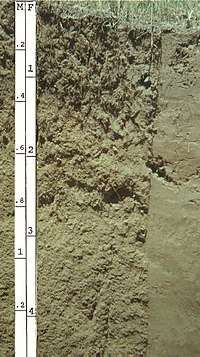Entisol
In USDA soil taxonomy, Entisols are defined as soils that do not show any profile development other than an A horizon. An entisol has no diagnostic horizons, and most are basically unaltered from their parent material, which can be unconsolidated sediment or rock. Entisols are the most abundant soil order, occupying about 16% of the global ice-free land area.
| Entisol | |
|---|---|
 Entisol profile showing little or no evidence of pedogenic horizon development | |
| Used in | USDA soil taxonomy |
In Australia, most Entisols are known as rudosols or tenosols. In the World Reference Base for Soil Resources (WRB), because of the diversity of their properties, suborders of Entisols form individual Reference Soil Groups: Psamments correlate with Arenosols and Fluvents with Fluvisols. Many Orthents belong to Regosols or Leptosols. Most Wassents and aquic subgroups of other suborders belong to the Gleysols.[1]
Causes of delayed or absent development
- Unweatherable parent materials – sand, iron oxide, aluminium oxide, kaolinite clay.
- Erosion – common on shoulder slopes; other kinds also important.
- Deposition – continuous, repeated deposition of new parent materials by flood as diluvium, aeolian processes which means by wind, slope processes as colluvium, mudflows, other means.
- Flooding or saturation.
- Cold climate – must not be sufficiently cold in winter for permafrost.
- Dry climate.
- Shallow to bedrock – may be rock resistant to weathering, such as quartzite or ironstone.
- Toxic parent materials – serpentine soil, mine spoils, sulfidic clays.
Suborders
- Aquents – permanently or usually wet soils formed on river banks, tidal mudflats etc. Here, general wetness limits development.
- Fluvents – alluvial soils where development is prevented by repeated deposition of sediment in periodic floods. Found in valleys and deltas of rivers, especially those with high sediment load.
- Orthents – shallow or "skeletal soils". Found on recent erosional surfaces or very old landforms completely devoid of weatherable minerals.
- Psamments – Entisols that are sandy in all layers where development is precluded by the impossibility of weathering the sand. Formed from shifting or glacial sand dunes.
- Wassents – Entisols that have a positive water potential at the soil surface for more than 21 hours of each day in all years.
Paleopedology
Most fossil soils before the development of terrestrial vegetation in the Silurian are Entisols, showing no distinct soil horizons. Entisols have been abundant in the paleopedological record ever since then, though, unlike other soil orders (Oxisols, Ultisols, Gelisols for instance) they do not have value as indicators of climate – though orthents might in some cases be indicated of an extremely old landscape with very little soil formation (as in Australia today).
See also
- Illuvium
- Pedogenesis
- Pedology (soil study)
- Soil classification
References
- "Entisols". USDA-NRCS. Archived from the original on May 9, 2006. Retrieved 2006-05-14.
- "Entisols". University of Florida. Archived from the original on September 18, 2004. Retrieved 2006-05-14.
- "Entisols". University of Idaho. Archived from the original on 2006-09-01. Retrieved 2006-05-14.
- IUSS Working Group WRB (2015). "World Reference Base for Soil Resources 2014, Update 2015" (PDF). World Soil Resources Reports 106, FAO, Rome.